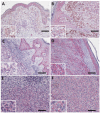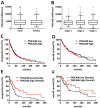The Prognostic Relevance of PMCA4 Expression in Melanoma: Gender Specificity and Implications for Immune Checkpoint Inhibition
- PMID: 35328746
- PMCID: PMC8949876
- DOI: 10.3390/ijms23063324
The Prognostic Relevance of PMCA4 Expression in Melanoma: Gender Specificity and Implications for Immune Checkpoint Inhibition
Abstract
PMCA4 is a critical regulator of Ca2+ homeostasis in mammalian cells. While its biological and prognostic relevance in several cancer types has already been demonstrated, only preclinical investigations suggested a metastasis suppressor function in melanoma. Therefore, we studied the expression pattern of PMCA4 in human skin, nevus, as well as in primary and metastatic melanoma using immunohistochemistry. Furthermore, we analyzed the prognostic power of PMCA4 mRNA levels in cutaneous melanoma both at the non-metastatic stage as well as after PD-1 blockade in advanced disease. PMCA4 localizes to the plasma membrane in a differentiation dependent manner in human skin and mucosa, while nevus cells showed no plasma membrane staining. In contrast, primary cutaneous, choroidal and conjunctival melanoma cells showed specific plasma membrane localization of PMCA4 with a wide range of intensities. Analyzing the TCGA cohort, PMCA4 mRNA levels showed a gender specific prognostic impact in stage I-III melanoma. Female patients with high transcript levels had a significantly longer progression-free survival. Melanoma cell specific PMCA4 protein expression is associated with anaplasticity in melanoma lung metastasis but had no impact on survival after lung metastasectomy. Importantly, high PMCA4 transcript levels derived from RNA-seq of cutaneous melanoma are associated with significantly longer overall survival after PD-1 blockade. In summary, we demonstrated that human melanoma cells express PMCA4 and PMCA4 transcript levels carry prognostic information in a gender specific manner.
Keywords: immune checkpoint inhibition; lung metastasis; melanoma; plasma membrane calcium ATPase 4.
Conflict of interest statement
E. Livingstone has had intermittent advisory board relationships with Roche, BMS, Novartis, Sanofi and Actelion and has received travel grants and honoraria from Roche, BMS, MSD, Amgen, Pierre Fabre, SunPharma, Novartis, Boehringer-Ingelheim, medac. Dirk Schadendorf received research funding from Novartis and Bristol-Myers Squibb, served as consultant or/and has received honoraria from Amgen, Leo Pharma, Roche, Bristol-Myers Squibb, Merck Sharp & Dohme, Novartis, Incyte, Regeneron, 4SC, AstraZeneca, Immunocore, Pierre Fabre, Merck EMD, Pfizer, Philogen, Sanofi, Inflarx, Neracare and Array and travel support from Novartis, Bristol-Myers Squibb, Merck Sharp & Dohme, Roche and Pierre Fabre. All other authors declare no conflict of interest. AZ: received travel support from Novartis, Sanofi Grenzyme, Sun Pharma, and Bristol-Myers Squibb, outside the submitted work.
Figures







References
MeSH terms
Substances
Grants and funding
LinkOut - more resources
Full Text Sources
Medical
Miscellaneous

